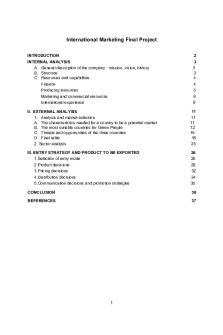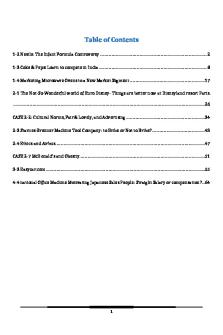Logitech International Case Questions Final PDF

| Title | Logitech International Case Questions Final |
|---|---|
| Author | Jack Kanter |
| Course | Financial Statement Analysis |
| Institution | Temple University |
| Pages | 3 |
| File Size | 104.8 KB |
| File Type | |
| Total Downloads | 79 |
| Total Views | 191 |
Summary
First case study of the course: Logitech...
Description
Logitech International Case Questions (27 points; 3 points per question) 1. Using the Consolidated Balance Sheets for Logitech International S.A. (Logitech) for March 31, 2010 and 2009, prepare a common-size balance sheet. See Appendix 1. 2. Evaluate the asset, debt, and equity structure of Logitech, and explain trends and changes found on the common-size balance sheet. Ensure you are thorough on this question! Logitech had a decrease in Cash from 35% of total assets to 20% due to their acquisition of LifeSize and TV Compass. Current Assets decreased from 70% of total assets to 49% which is concerning because current assets describe those that are most liquid on the balance sheet. Goodwill increased from 19% to 41% of total assets showing that Logitech overplayed for their 2010 acquisitions of LifeSize and TV Compass. This is proved in Logitech’s decrease in Net Income of $42,075,000. Based on their increase in Goodwill and decrease in Net Income, Logitech overpaid for the acquisitions of LifeSize and TV Compass and their poor performances are hurting profits. Accounts Payable increased by 5% of total assets. This is an issue because Logitech has several bank lines of credit with no borrowing limits in place. This increase in spending indicated credit problems for Logitech. Additional paid in capital decreased by about $30 million, indicating that investors did not purchase stock as much above par value in 2010 as they did in 2009. 3. Analyze accounts receivable and allowance for doubtful accounts. Logitech operates with a high accounts receivable balance because it sells massive inventory to huge clients. For example, as of March 31, 2010, a single customer was responsible for 14% of the accounts receivable balance. Logitech manages the AR credit risk through ongoing credit evaluations of their customers’ financial conditions. Logitech’s allowance for doubtful accounts is based on company’s regular assessment of creditworthiness and historical experience with bad debts, risks, etc. with their customers. 4. What inventory method is used to value inventories? Does this method reflect current cost at year-end? Logitech uses the first-in-first-out (FIFO) method to value their inventories. This method does not reflect current cost at year end. The FIFO method does reflect the current cost at year-end because the recent purchases are used to calculate ending inventory. 5. Discuss the commitments and contingencies of Logitech and the significance of these items. There are approximately nine! There are different commitments and contingencies Logitech displayed in the provided balance sheet and 10-K. The first is $46.7M in future non-cancellable operating lease
payments. Also, Logitech has fixed purchase commitments of $12.9M as of March 2010. These are primarily related to “commitments for manufacturing equipment, tooling, computer software, and computer hardware.” Logitech has $183.6M in inventory commitments, which are expected to be fulfilled by December 31, 2010. Logitech additionally had $33.3M in commitments for consulting, marketing, and advertising services. Logitech has indemnification agreements with select suppliers and customers. Logitech’s agreement with acquisition WiLife Inc. has different commitments and contingencies associated with it. Logitech has performance-based payments of a maximum of $64M which they may have to pay in the future. They also have $3.4M in letters of credit issued to various third parties, $0.3 of which is outstanding. Logitech has lawsuit contingencies that they may have to pay in the near future. Commitments and contingencies are significant to a company because they are obligations to pay and potential obligations depending on outcomes of future events. It is important for investors to factor in a company’s commitments and contingencies because, if material, they can significantly impact the company’s performance. 6. Explain what has caused the change in the retained earnings account from March 31, 2009 to March 31, 2010. The difference in Retained Earnings from 2009 to 2010 is $64,957,000. That is the same amount reported as Logitech’s 2010 net income, which means that they did not pay dividends in 2010. 7. Discuss any positive items learned about Logitech from the balance sheet and excerpts from the Form 10-K. There are several positive takeaways from the balance sheet and excerpts from Logitech’s 10-K. The first item is the decrease in accounts receivable of $18,682,000 which indicates that Logitech collected payments from customers. Another positive item is that Logitech regularly conducts credit evaluations of their customers in order to reduce their credit risk, which reassures shareholders. Another positive item learned is that they are making frequent acquisitions. In 2010, Logitech acquired LifeSize and TV Compass, and in 2009 they acquired SightSpeed and Ultimate Ears. They also began the pre-acquisition process for a company called WiLife in 2009. This indicates to financial statement users that the company is making use of their cash through expansion. The 2010 debt ratio is 37.51% whereas the equity ratio is 62.49%. This indicates that Logitech is relying more heavily on equity than debt, which is positive. 8. What concerns would investors and creditors have based on only this information? Logitech’s investors and creditors should have a number of concerns based on the information presented. They are currently involved in a number of lawsuits that could damage Logitech’s reputation and drain financial resources. Not only expensive in nature but they deter investors from the company. Logitech did not pay dividends in 2010 which
could indicate a weak financial position. This could also cause the stock price to fall. From an investor’s point of view, it is concerning that Logitech repurchased treasury stock possibly decrease the number of shares and increase the share price. Overall, investors and creditors need more than just two year of financial data to substantially evaluate a company’s performance, however Logitech’s largest issues include a decline in revenue and profits, their commitments and contingencies, theft that Goodwill makes up over 60% of equity and acquisitions are risky. 9. What additional financial and nonfinancial information would investors and creditors need to make good investing and lending decisions for Logitech? Be thorough. Additional financial information to help investors and creditors evaluate decisions involving Logitech would include financial information from the last four or five years including pro forma income statements and balance sheets. Outside investors would also like to see the liquidity of Logitech and the speed of which their liquid assets can be converted into cash as well as the financial information from the companies Logitech acquired. Additionally, non-financial information would include the quality of management within the company....
Similar Free PDFs

Logitech inventory fraud pdf
- 1 Pages
Popular Institutions
- Tinajero National High School - Annex
- Politeknik Caltex Riau
- Yokohama City University
- SGT University
- University of Al-Qadisiyah
- Divine Word College of Vigan
- Techniek College Rotterdam
- Universidade de Santiago
- Universiti Teknologi MARA Cawangan Johor Kampus Pasir Gudang
- Poltekkes Kemenkes Yogyakarta
- Baguio City National High School
- Colegio san marcos
- preparatoria uno
- Centro de Bachillerato Tecnológico Industrial y de Servicios No. 107
- Dalian Maritime University
- Quang Trung Secondary School
- Colegio Tecnológico en Informática
- Corporación Regional de Educación Superior
- Grupo CEDVA
- Dar Al Uloom University
- Centro de Estudios Preuniversitarios de la Universidad Nacional de Ingeniería
- 上智大学
- Aakash International School, Nuna Majara
- San Felipe Neri Catholic School
- Kang Chiao International School - New Taipei City
- Misamis Occidental National High School
- Institución Educativa Escuela Normal Juan Ladrilleros
- Kolehiyo ng Pantukan
- Batanes State College
- Instituto Continental
- Sekolah Menengah Kejuruan Kesehatan Kaltara (Tarakan)
- Colegio de La Inmaculada Concepcion - Cebu














